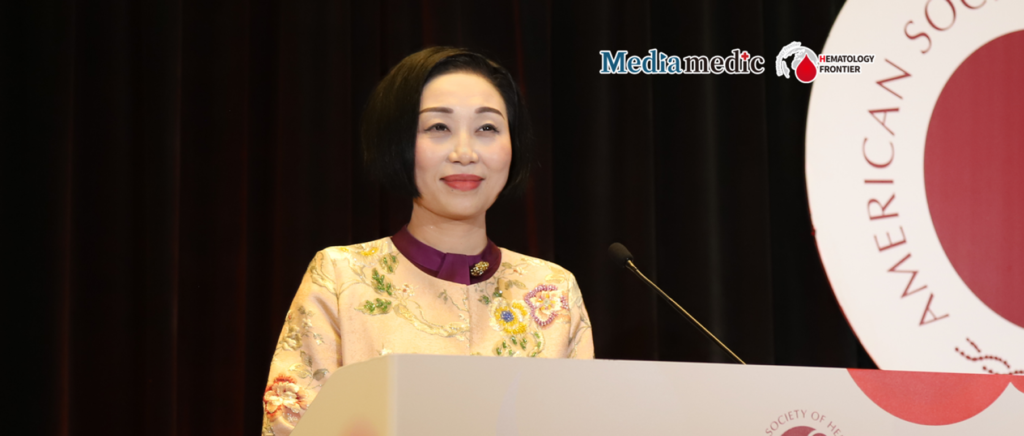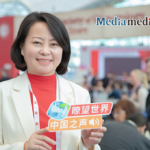
Editorial Note: The 66th Annual Meeting of the American Society of Hematology (ASH), held from December 7–10, 2024, in San Diego, USA, brought together global hematology experts to discuss the latest advancements in the field. Among the highlights of this year’s conference were seven groundbreaking studies from Dr. Xiaowen Tang’s team at The First Affiliated Hospital of Soochow University. These included two oral presentations (O270, O683) and five poster presentations (P3384, P3493, P4197, P4284, P4836). Covering key areas such as acute myeloid leukemia (AML), acute lymphoblastic leukemia (ALL), multiple myeloma (MM), CAR-T cell therapy, and hematopoietic stem cell transplantation (HSCT), the research showcased the team's innovative contributions to hematology. Hematology Frontier interviewed Professor Tang on-site to explore the clinical significance of the two oral presentations, injecting new vitality into the advancement of hematology.Hematology Frontier: The issue of relapse post-allo-HSCT remains critical for high-risk or relapsed/refractory (r/r) ALL patients. How might the VA regimen combined with a modified BuCy preconditioning strategy impact clinical practice? What criteria should guide the selection of patients for this combined treatment?
- Dr. Xiaowen Tang:
For high-risk and relapsed/refractory ALL patients, relapse rates remain alarmingly high—ranging from 50% to 80%—even after allogeneic hematopoietic stem cell transplantation (allo-HSCT). Early relapse, particularly before the graft-versus-leukemia (GVL) effect has fully developed, is often driven by residual tumor burden that was not deeply cleared during preconditioning.
Preventing post-transplant relapse involves a systematic management approach spanning preconditioning regimens, prophylactic measures for graft-versus-host disease (GVHD), post-transplant maintenance therapies, preemptive interventions, and continuous monitoring of minimal residual disease (MRD). Among these, the choice of preconditioning regimen is especially critical.
The ideal preconditioning strategy enhances anti-tumor effects while minimizing toxicity to normal tissues and organs. Drug selection must balance efficacy and safety, achieving broad-spectrum anti-tumor activity or complementing traditional BuCy regimens through distinct mechanisms of action.
In our study, we adopted a non-chemotherapy regimen combining venetoclax and azacitidine (VA), targeting oxidative phosphorylation pathways in leukemic stem cells. This approach offers a novel avenue for deep tumor stem cell clearance. The results were highly encouraging: one-year overall survival (OS) and leukemia-free survival (LFS) rates were 94.1% and 87.8%, respectively. The one-year cumulative incidence of relapse (CIR) was 6.7%, and non-relapse mortality (NRM) was 5.9%. These outcomes highlight the regimen’s efficacy, safety, and potent anti-tumor effect, marking a significant breakthrough in treating extremely high-risk patients.
Study Highlight
- O270:
Safety and Efficacy of VA Combined with Modified BuCy Conditioning Regimen Followed By Allo-HSCT for High-Risk or Refractory/Relapsed Acute Lymphoblastic Leukemia : A Prospective, Single-Center, Single-Arm Clinical Trial
Hematology Frontier: Could you provide background on the sequential infusion of anti-CD19 and anti-BCMA CAR-T cells for refractory immune-mediated platelet transfusion refractoriness (riPTR)? Additionally, what was the most surprising finding of your study?
- Dr. Xiaowen Tang:
Platelet transfusion refractoriness (PTR) is a critical but often overlooked challenge in clinical practice, especially during the treatment of leukemia. Many leukemia patients undergoing chemotherapy or transplantation face periods of pancytopenia, where platelet transfusion is a cornerstone of supportive care. However, PTR, particularly refractory immune-mediated PTR (riPTR), complicates care for certain high-risk patients, such as those with a history of multiple pregnancies, transfusions, autoimmune diseases, or other contributing factors like splenomegaly or medication effects.
In cases of riPTR, even sufficient platelet transfusions fail to increase platelet counts, leaving patients at high risk for severe bleeding events, including life-threatening intracranial hemorrhages. This issue not only extends hospital stays but also significantly increases healthcare costs and resource utilization. Moreover, some patients may lose the opportunity for transplantation or chemotherapy due to PTR-related complications. Despite various attempts, including plasma exchange, immunoadsorption, anti-CD20 antibodies, and bortezomib, riPTR remains a difficult problem to address.
Our team explored CAR-T cell therapy as a novel approach. B cells and plasmablasts are the main antibody-producing cells, and anti-CD19 CAR-T and anti-BCMA CAR-T therapies can effectively eliminate these cell populations. By sequentially administering these CAR-T therapies, we aimed to eradicate the cells responsible for producing antibodies, including anti-HLA and anti-HPA antibodies, and thereby address the underlying cause of riPTR.
The results were remarkable, achieving what we described as a “three-in-one” outcome:
- Complete Clearance of Platelet-Associated Antibodies: The sequential CAR-T therapy successfully eradicated all platelet-associated antibodies, significantly reducing PTR incidence during subsequent chemotherapy or transplantation, effectively overcoming this clinical hurdle.
- Improved Transplantation Outcomes: Many PTR patients carry donor-specific antibodies (DSA), increasing the risk of poor graft function (PGF) or delayed platelet engraftment post-transplantation. Pre-transplant clearance of these antibodies ensures successful platelet transfusion, facilitates graft implantation, and reduces the risks of PGF and graft rejection.
- Sustained Molecular Remission: In our study, which included nine AML patients and three ALL patients, the median follow-up was 33.5 months. An impressive 91.7% of patients achieved sustained molecular remission. The sequential CAR-T therapy not only eliminated antibodies but also effectively eradicated minimal residual disease (MRD), significantly lowering post-transplant relapse rates.
This strategy has immense potential, not only in hematologic diseases but also in areas like autoimmune diseases and organ transplantation. Future multicenter, prospective clinical studies will be essential to validate its efficacy and safety, paving the way for broader application and offering new hope to more patients.
Study Highlight
- O683:
Sequential Infusion of Anti-CD19 and Anti-BCMA Chimeric Antigen Receptor T-Cells: A Promising Treatment Strategy for Refractory Immune-Mediated Platelet Transfusion Refractoriness
Hematology Frontier: These two studies provide new perspectives for hematologic oncology. How do they align with current trends, and what insights do they offer for the development of future treatment strategies? Additionally, what are your expectations for optimizing and scaling these therapies?
Dr. Xiaowen Tang:
The future of medicine lies in the comprehensive integration of diverse treatment modalities, including novel drugs and innovative therapies. For example, our clinical research demonstrates the versatility of combining venetoclax and azacitidine in transplantation for ALL, showcasing their potential in various therapeutic settings.
Similarly, the integration of CAR-T cell therapy with transplantation highlights its value in overcoming critical challenges, such as PTR. By effectively removing barriers to graft implantation, CAR-T therapy enhances transplantation success rates and overall survival.
These findings reflect a broader trend toward treatment diversification, incorporating chemotherapy, radiotherapy, targeted therapies, immunotherapy, CAR-T therapy, and transplantation into individualized care plans tailored to each patient’s needs. The ability to flexibly apply these modalities can improve outcomes, extend disease-free survival, and enhance patients’ quality of life.
As we look ahead, optimizing these therapies through further clinical research will be critical. Expanding their application in larger patient populations and diverse clinical settings will help unlock their full potential, bringing transformative benefits to patients worldwide.
Poster Presentations by Dr. Xiaowen Tang’s Team at ASH 2024
Dr. Xiaowen Tang’s team from The First Affiliated Hospital of Soochow University presented multiple impactful posters at the 66th Annual Meeting of the American Society of Hematology (ASH) in 2024. Below is a summary of two notable poster presentations showcasing innovative approaches to treating multiple myeloma (MM) and high-risk acute myeloid leukemia (AML).
Poster 1
Abstract Number: 3384
English Title: Bird Regimen Followed by Anti-BCMA CAR-T Cell Immunotherapy as First-Line Therapy for Newly Diagnosed Multiple Myeloma: A Prospective, Single-Arm, Phase 3 Trial
First Authors: Yue Zhou, Juan Chen
Corresponding Authors: Xiaowen Tang, Depei Wu
Poster 2
Abstract Number: 3493
English Title: VA Combined with mBuCy Conditioning Regimen Followed by Allo-HSCT Can Improve Survival of High-Risk AML Patients: A Prospective, Single-Center, Single-Arm Clinical Trial
First Author: Wei Cui
Corresponding Authors: Xiaowen Tang, Depei Wu
Poster 3
Abstract Number: 4197
English Title: Chemotherapy-Free Induction with Venetoclax and Azacitidine, Followed by Tandem CD19/CD22 CAR-T Cell Therapy as First-Line Treatment in Newly Diagnosed High-Risk Philadelphia Chromosome-Negative Acute Lymphoblastic Leukemia: A Prospective, Single-Center, Single-Arm, Phase 2 Trial
First Author: Mengyun Li
Corresponding Author: Xiaowen Tang
Poster 4
Abstract Number: 4284
English Title: How to Improve the Efficacy of Venetoclax and Azacitidine for Newly Diagnosed Acute Myeloid Leukemia? A Prospective, Single-Center, Single-Arm Phase 2 Trial for Newly Diagnosed AML
First Author: Xuekai Li
Corresponding Authors: Xiaowen Tang, Depei Wu
Poster 5
Abstract Number: 4836
English Title: Unleashing the Power of CD19 CAR-T in Relapsed AML: Findings from a Prospective Single-Center Clinical Trial
First Author: Jia Yin
Corresponding Authors: Xiaowen Tang, Depei Wu


